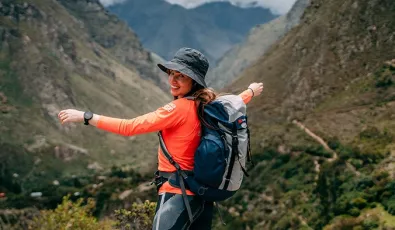An Inca Trail Training Schedule! Before setting out on any long trek like the Inca Trail to Machu Picchu, proper planning must occur first in order to be equipped for what lies ahead and to help prepare ourselves, so here we offer this Inca Trail training program as an integral component.
The Inca Trail is one of the world's premier walking paths and with good reason: over four days it passes through some of Peru's most stunning landscapes, from cloud forests and further cloud forests all the way up to Machu Picchu itself!
With some careful preparation, taking on the Inca Trail can become one of the most incredible experiences of your life.
Inca Trail to Machu Picchu Complete Training Plan!
Some tips for your Inca Trail training plan
Befitting yourself before hiking the Inca Trail requires fitness preparation. With its steep gradient and need to carry equipment, its terrain requires strong fitness to navigate it successfully. Use this training schedule as part of your preparation program for this trek.
Take short walkings
Begin training two to four months prior to departure date by taking quick strolls along your local trails; as departure date nears, gradually increase miles and elevation gradually. Due to numerous steep sections along the Inca Trail, make sure that hill work forms part of your workouts!
Begin training two to four months prior to departure date by taking quick strolls along your local trails; as departure date nears, gradually increase miles and elevation gradually. Due to numerous steep sections along the Inca Trail, make sure that hill work forms part of your workouts!
Working on your aerobic fitness
For anyone interested in trekking the Inca Trail, aerobic exercise is key. Covering 26-miles takes four days; to prepare properly before undertaking this hike can sometimes prove challenging and aerobic exercise can make an immense difference in terms of overall endurance.
Improve your aerobic fitness to avoid getting worn down during hikes without feeling overexerted by swimming, cycling or running for 30 minutes at least before engaging in any physical activity that raises the heart rate.
Work on muscular strength
A variety of methods exist for building up this aspect of strength: weightlifting, resistance bands and bodyweight exercises are just a few ways you can hone it. Squats and lunges will do wonders to build leg muscles; to expand arm and back muscle development consider pushups or pullups as upper body exercises - you'll soon be prepared to conquer the Inca Trail with consistent effort!
Work on Cardiovascular endurance
Given the altitude of the Inca Trail, having a healthy heart will be essential in adapting to its thinner air. Be sure to include cardio exercises in your workouts such as running, biking or swimming to get you ready. As your trek date nears, gradually increase length and intensity of training so that it makes sure your hike will be successful and pleasurable!
Resistance and Weight Training.
Resistance training strengthens your body to handle the demands of an upward hike by strengthening it through resistance exercises such as leg presses, lunges and squats - among others - which make for great resistance training exercises.
On the flipside, weight training provides you with a powerful way to build up strength and muscle mass for both daily life and Inca Trail adventures alike. Weightlifting or bodyweight workouts such as push-ups can both serve as effective forms of resistance training.
Cross-fit Training
Cross-Fit Exercise can be an excellent way to prepare for the Inca Trail. Cross-fit training entails short bursts of high intensity exertion followed by rest intervals, strengthening muscles and increasing cardiovascular endurance as well as decreasing body fat while simultaneously increasing fitness levels and overall wellness.
Prepare your Inca Trail hiking gear in advance
Gear up in preparation to hike the Inca Trail by selecting appropriate clothing items when packing a backpack. With respect to climate and anticipated hiking conditions, dress in accordance with expected conditions: light yet loose fitting clothing can keep you cool during hot conditions while layers allow you to adapt quickly in cold climate conditions.
When hiking on uneven or inhospitable terrain, footwear with strong grip should be your number-one consideration. Conversely, on flat trails such as asphalt roadways you might get away with wearing lighter sneakers or lightweight footwear instead.
No matter the season or temperature, make sure your attire is comfortable and doesn't restrict movement. Also remember to pack a hat, sunscreen and insect repellent just in case!
Take note
We invite you to learn about the difference between hiking and trekking.
How to Choose the Right Hiking Gear
When planning either a day trek or longer backpacking expedition, selecting appropriate hiking equipment is absolutely key. Your needs depend upon factors like length of trek planned, climate conditions of hike and distance travelled as well as what kind of terrain will be covered; for this purpose you may require different pieces.
Best hiking equipment
Hikers require hiking boots that provide adequate ankle support. Choose boots with soft leather uppers that feel good to the touch.
Hikers should equip themselves with an appropriate backpack. A suitable one should be spacious enough to store all their possessions while being comfortable to carry; before choosing one, try on several styles so you know it fits you properly; Osprey makes some excellent backpacks in this regard.
Hiking poles are another key piece of gear for hiking adventures; these can help maintain balance on uneven ground, relieve arm and leg strain and ensure arm/leg fatigue is lessened. As with anything, choosing the model that feels most natural should be your goal.
Last, be sure to pack enough food and beverages for your hike. It is always better to be overprepared than underprepared, particularly if spending any extended period in remote places.
Familiarize yourself with your hiking gear
How to break in your hiking boots
If this is your first pair of hiking boots or you are new to hiking, breaking them in is key before hitting the trails. Here are a few helpful suggestions on how to do just that:
- Wear your boots around the house. Spending some time walking in them over time will enable you to gauge their fit and provide support more accurately.
- As soon as your boots feel comfortable indoors, go on short strolls around your neighborhood or nearby park to gain more of an idea about their fit and how well they perform on various terrain. Doing this will allow you to assess how they handle different surfaces.
- Take short treks. After wearing and becoming comfortable with your boots for several days, now it is time to break them in on the trails and see how they handle various terrain and height variations. Begin with simple short hikes until you gain more knowledge.
- Be patient! Breaking in hiking boots that fit well is worth your while; soon enough you'll be prepared for whatever adventures await!
By persevering you will soon have yourself ready for adventure.
Tips for using hiking poles
When hiking on unsteady or slippery terrain, hiking poles are an invaluable aid to increasing stability and support. Here are a few pointers on using hiking poles:
- Hold both poles with both hands at first, with tips pointing downwards. As you walk forward with them in front of you, ensure the tips touch down first on the ground before planting them behind you as part of your walking pattern.
- Utilise arms and shoulders instead of just wrists alone when powering them - keep elbows close to torso when swinging them!
- Utilize shorter strides and plant poles more regularly when climbing hills; when going downhill, let gravity take its course by dropping your poles completely and letting gravity take its course instead of holding onto them as much.
By following these suggestions you may maximize the benefit of hiking poles to enhance the experience of your journey and maximize their use effectively.
Mental preparation for the Inca Trail
As part of an Inca Trail trek, mental and physical preparation are both equally essential. Many factors will have an effect on your experience on this challenging trail: inclement weather, long days and rough terrain require mental preparation if they pose challenges during your experience.
Tips for mental preparation
Before setting out on this challenging trek, take time to consider your actions and motivation so as to ensure maximum enjoyment while creating priceless memories on this unforgettable experience.
- Imagine yourself succeeding
- Establish manageable objectives along the way
- Each day, set aside some alone time just for you - to relax and unwind
- Before setting out on any excursion, ensure that you receive enough rest.
- To stay energetically charged throughout your adventure, consume a balanced diet and drink enough water daily.
Acclimatize before the Inca Trail
Before embarking on the Inca Trail, take steps to acclimate. Acclimatization refers to the process whereby our bodies adapt to new environments such as different climate, altitude or terrain conditions; before setting out on such an ambitious journey as hiking the Inca Trail it's vital that your body has time to become used to the thinner air at higher altitudes; otherwise altitude sickness symptoms might include exhaustion, shortness of breath headache or nausea - symptoms to keep an eye out for when hiking this trail
The process of acclimatization
Acclimatization is key when prepping for any high-altitude climb, including the Inca Trail. Progressive exposure over multiple days to higher altitudes will lower your risk of altitude sickness while improving chances of having a safe and successful excursion.
As part of your efforts at adapting, it's vitally important that you consider:
- Give yourself plenty of time for your body to adjust to any altitude changes by giving yourself enough lead-in time. Most people need at least several days at moderate height (between 2,500-3,000 meters/8,200-9,800 ft). 2.
- Climb High, Sleep Low: To optimize acclimatization during your trek, aim for hiking uphill each day during daylight hours and sleeping low each evening in order to help your body adjust to thinner air. At nightfall, drop back down to lower altitudes in order to rest your muscles after exertion and make further adaptations in response to lower oxygen levels.
- Hydration is of vital importance at any altitude, but becomes particularly critical in high alpine environments.
Why is it important to acclimatize before the Inca Trail?
One of the world's premier trekking paths, located deep within Andean mountains and rising over 4,00 meters is no secret, making acclimatization to such high altitudes vitally important before undertaking such an endeavor. Without appropriate preparation however, hiking the Inca Trail may present significant difficulties; these problems could become especially evident for hikers unfamiliar with high elevation terrain.
As such, pre-acclimatizing is absolutely key when beginning the Inca Trail. By spending some time at lower altitudes prior to setting out on this trek, your body can acclimatize more easily and may reduce chances of altitude sickness; you will find your experience much more pleasant as a result!
How to acclimatize before the Inca Trail
In order to successfully experience trekking the Inca Trail, it's essential that you prepare properly in terms of adapting gradually to its high altitude in order to prevent negative consequences when hiking. To do so effectively will ensure a more pleasurable hiking experience!
Your body needs time to adjust; to aid this process you can do several things such as:
- Staying hydrated requires sipping plenty of fluids - particularly water!
- Rest and sleep regularly so your body has time to recuperate after each day's activities.
- Avoid tobacco and alcohol products which can dehydrate the body and make acclimatisation to altitude more challenging.
- To maintain proper energy supply for the body, be sure to consume an array of complex carbs such as whole grains. This can give your body what it needs.
Assuring your journey on the Inca Trail will be safe and fulfilling is simple by following these instructions before setting out on it.
Tips for acclimatizing
Before setting out on the Inca Trail, it's crucial that your body can adapt to its high altitude environment. This is particularly important if coming from lower altitude environments as this process will take time for you. Here's some helpful advice to get yourself ready::
- Staying hydrated requires drinking lots of fluids - particularly water - every day, such as juice.
- Avoid caffeine and alcohol to protect the body against dehydration.
- Eat small meals frequently and avoid foods rich in lipids that may be difficult to digest at high altitudes.
- To assist your body with adapting, get plenty of rest and participate in regular physical activity.
If you experience symptoms of altitude sickness such as headache, nausea or exhaustion, descend immediately and seek medical assistance.
Arriving early to Cusco
Ascending to Cusco in plenty of time to adjust to its high altitude is vital if you intend on hiking the Inca Trail; its starting point lies over 11,000 feet above sea level - double what Denver, Colorado sits.
Altitude sickness can result in headaches, nausea, vertigo and difficulty sleeping - symptoms which require caution to overcome. Before setting out on any hike or trek in altitude sickness conditions it's wise to remain hydrated throughout and consider taking at least a couple days off so as to rest up and adapt more gradually to altitude changes.
Tips for hiking the Inca Trail
1. Get Acclimatized. Since the Inca Trail climbs over 13,000 feet in altitude, allow yourself sufficient time for your body to adapt prior to setting out on its journey. Spend several days getting acquainted with Cusco or another nearby city before beginning this exciting trek.
2. Hike itself should not be taken lightly. Even for experienced hikers, the Inca Trail can be dauntingly long; give yourself enough time for completion, and don't feel afraid to turn back if feeling overwhelmed.
3. Pack light but intelligently. Since you will be carrying everything on your back, ensure you bring enough food and beverage for the entire journey. If clean water sources may prove challenging along your route, bring along a water purification device such as a filter. Finally, choose high energy snacks which won't weigh down your traveler's pack too quickly.
4. Anticipate changing weather. Be ready for anything from scorching sun to cool rain or snowfall as the Inca Trail traverses multiple temperature zones. Layer up clothing as required, keeping an umbrella handy just in case of unpredictable conditions, and ensure a waterproof jacket is always within easy reach just in case unforeseen problems arise.
What to do if you get lost while hiking
The key to being unafraid and maintaining composure when hiking can be found by breathing deeply several times before taking an assessment of your surroundings and looking around to identify landmarks to aid with orientation, but if that does not help find them then simply retracing back your steps until the most recent trail intersection or fork in the road - from there, figure out your intended course back home by making decisions according to which direction is most efficient for returning there
Ultimately, staying put may be your best course of action if backtracking does not work or if you cannot seem to find your way home. When waiting for help to arrive, find somewhere comfortable where you can sit or lie down; waving bright colored clothing or lighting a signal fire will help rescuers spot you more easily; most important of all though: avoid wandering out in search of assistance as that only increases their difficulty of locating you!




Add new comment